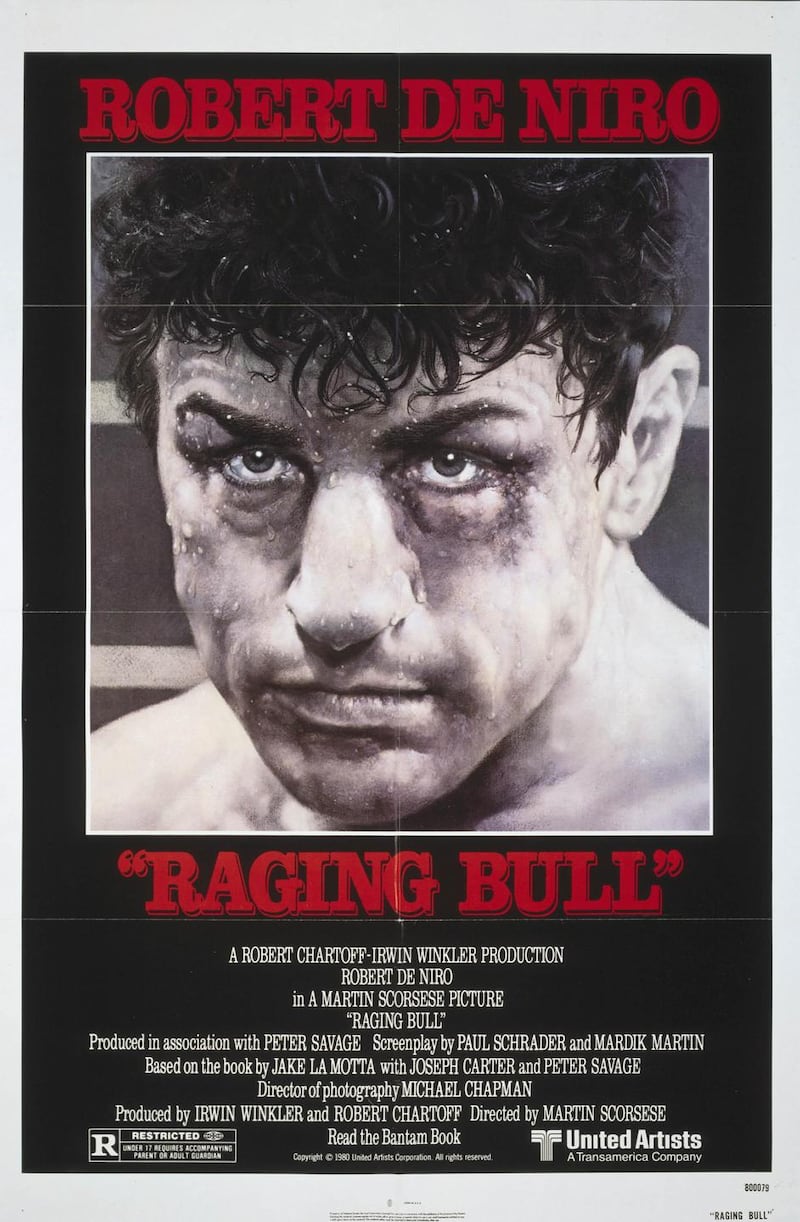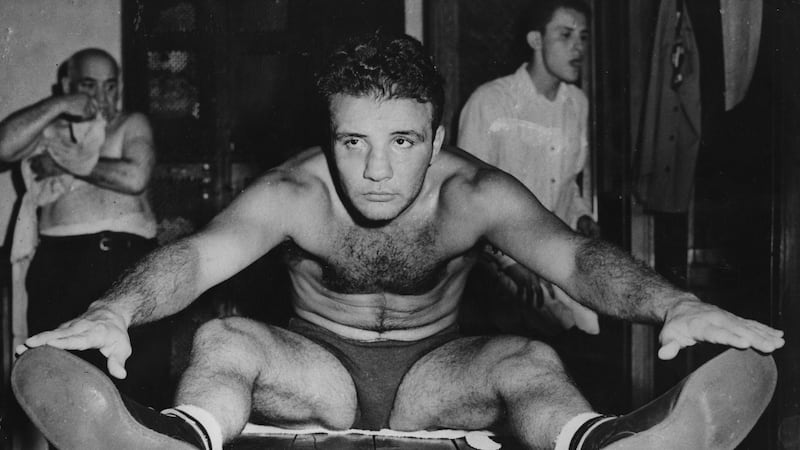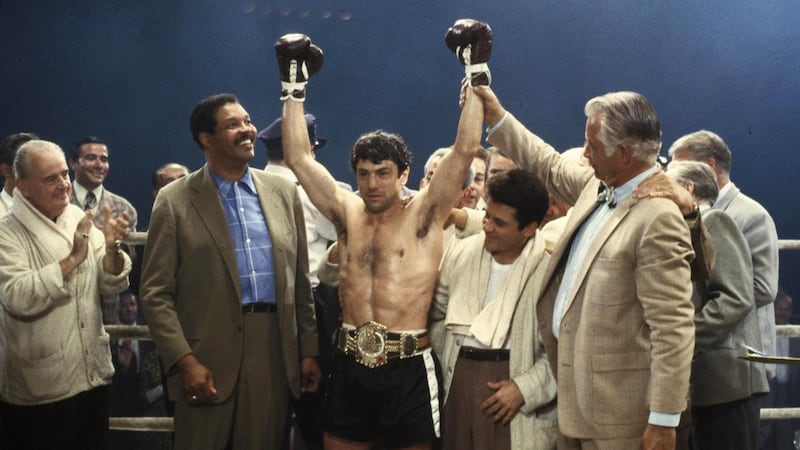It is 1964. Shirt buttons straining around his midriff, Robert De Niro’s overweight character Jake LaMotta, the troubled and troubling former middleweight world champion, looks at himself in a backstage mirror. His nose is scarred and misshapen.
Shooting in black-and-white, the still camera captures the grime around him and the doggerel he struggles to remember, suggesting that, in life, LaMotta is no longer on his way up.
“So gimme a stage where this bull here can rage. And though I can fight, I’d rather recite,” says the ageing boxer to himself. No longer the Raging Bull.
The movie then cuts to 1941 and the face of a younger LaMotta distorting as the punches connect in his fight against Jimmy Reeves, the moving camera positions changing direction as if placed on the gloves or shoulders of both boxers.
Flashlights explode in the background, cigar smoke spirals. LaMotta is hit. He staggers forward. He is hit again, he staggers forward, always forward.
A close-up of gore spraying from his nose, he is helped to his corner by brother Joey, played by Joe Pesci. The blood-soaked sponge and first line of dialogue from Joey sets the tone for the next two hours.
“Tell me why,” screams Joey. “Tell me why the fuck we have to come to Cleveland for you to be beaten by a moulan yan [eggplant].”

Celebrated despite claiming just 10 minutes of the film, the noir feel of the fight sequences are cut with documentary footage of LaMotta in his corner. Sharply edited with an emphasis on impact and body damage, a telling half smile on LaMotta’s face reveals early and more than once that he doesn’t at all mind the slapping hurt.
It is the only ennobling flash of humanity we get from DeNiro's portrayal. LaMotta's acceptance, even celebration of the beating he receives from Sugar Ray Robinson, who he fights five times, is an act of contrition for the pain he causes to those he loves most.
It is all to the operatic backdrop of the Intermezzo from Cavalleria rusticana by Italian composer Pietro Mascagni, and long before the classical music score became a modern-day cliche as a counterpoint for epic violence.
Assaults and brutality
The shock value of Raging Bull is in the assaults and brutality, which are not confined to LaMotta fighting his way to the world title. Already in his 10th professional bout when the biopic enters his fighting life, he is already far along the path of drawing no distinction between the ring canvas and the kitchen. His fury is multi-directional.
Not many movies get close to director Martin Scorsese's chill factor in his treatment of the New York boxer. It is a portrait of psychotic violence and paranoia. In almost every scene De Niro articulates hair-trigger menace against his two wives, particularly his second wife, Vikki, played sublimely by Cathy Moriarty, mob members, Joey, his opponents, sparring partners and himself.
“Punch me in the face,” demands De Niro of Joey in one of the opening scenes, the snares of scar tissue around his eyes and thin lines of stitches and their pink welds not yet healed. He goads him further and Joey finally punches him. “Harder!” screams LaMotta. Nine times later the wounds open.
“What does that prove?” screams Joey. Blood trickling down his cheek, LaMotta smiles at his brother and fondly pinches him on the chin.
If there is a Hollywood tie-up, an ending that comes to any kind of a moral conclusion or sends a principled message, it is not visible. There is no triumph over adversity
There is no effort by Scorsese to explain the irreparably depraved, crouching brawler of a boxer, who arrives on screen a ready-made ball of threat and jealousy out on the spectrum’s extreme. Vikki will become both the object of his imagined suspicions and his live-in punchbag.
“Come here before I give ya a beatin’,” is the unsettling courtship line he playfully calls to the then 15-year-old after his first, badly beaten wife has been discarded. By then the audience already knows what the coming months will bring to the vulnerable teenager.
De Niro and Scorsese show nothing of beauty in LaMotta. There is little that redeems the main character in a world where his fists may be gold but, in the goon-managed sport of boxing, nothing is within his control. Ultimately, LaMotta is forced to take a dive to “a bum” in order to get a shot at the world title.
But he theatrically loses the fight and, although suspended, is also rewarded, the mob repaying him with a title shot in 1949, when he violently beats Frenchman Marcel Cerdan. The fissures by then have already appeared and widened towards a grim and exhausting end.
Local hoods
At one point when LaMotta is away training, Joey sees Vikki innocently having a drink with connected local hoods. Knowing what reaction this will invite if the boxer finds out, Joey goes to the table and tells her to leave, explaining the danger to which she has exposed herself.
“Well, go ahead, tell Jake. He’s gonna kill me anyway. It’s a matter of time,” she says.
If there is a Hollywood tie-up, if there is an ending that comes to any kind of a moral conclusion or sends a principled message, it is not visible. There is no triumph over adversity as in Rocky II, which came out in 1979, and Rocky III, which was released in 1983.
At best, if there is a summing-up, it is that LaMotta gets what he deserves, Vikki and Joey leaving him to finally and alone trade on his name as a low-rent stand-up raconteur in poorly lit strip joints and speakeasies.

Released in 1980, the film presents, after another recent viewing, as more sinister and distressing than it did then, which is itself disturbing. It begs the question whether 40 years ago last November, when Raging Bull was released in New York, that such gross acts against women, the persecution of Vikki and ultimately the closed-fist punch that knocks her out cold after LaMotta assaults his brother in front of his family, were seen as less sickening.
The boxing, for which Scorsese has publicly claimed little affection, ultimately becomes a metaphor for the arc of LaMotta’s violent life and loss to the backdrop of a phenomenal tally of 106 professional fights.
In 1941 he fought 14 times and in the month of June alone he took three fights. In 1942 again he was tearing it up 14 times and the following year 13 times. In a three-year spell LaMotta fought 41 times.
This is unheard of now. Katie Taylor has fought professionally 17 times in four years and Michael Conlan 14 times since turning professional after Rio 2016. World heavyweight champion Anthony Joshua has had 24 fights since turning professional some months after London 2012; in seven years he's had fewer fights than LaMotta had in 1941 and 1942.
Attrition
With that rate of attrition, there is an argument that LaMotta was also the victim in a sport that was run as a criminal enterprise and didn’t much care about the bodies it needed to feed the churn of rigged betting scams. But Scorsese wasn’t interested in that aspect. The fighter’s welfare in the sport was never a theme.
The magic of Scorsese, De Niro and Paul Schrader, who reworked the original script by Mardik Martin, was the inventive lighting and framing of the scenes and the unblinking exploration of the dark heart of the world champion boxer.
Not just indifferent to the fighting, Scorsese was a sporting agnostic, and it was largely De Niro’s hunger that drove LaMotta’s autobiography Raging Bull: My Story onto to the screen. He had read the book while shooting The Godfather Part II.
Even original script writer Martin was cool at the beginning, dismissing the storyline as derivative. “The trouble is the damn thing has been done a hundred times before: a fighter who has trouble with his brother and his wife and the mob is after him,” said Martin.

Scorsese, though, must have believed the alchemy was right for something special to emerge, his choice of black-and-white not just for texture and mood but of pragmatism. Colour he knew would degrade over time, so he chose not to use it.
De Niro, faithful to the uncompromising method-acting school, put on 60 pounds to play the older version of LaMotta, and won his second Academy Award in 1981 for this performance. Along with that came a Golden Globe win as well as a Bafta for Pesci as best newcomer. It was Pesci's first major role. But when it was premiered in New York the response was lukewarm and polarised.
Now Raging Bull ranks as cinematic art from an actor and director at the height of their powers and, in the moment of making the movie, somehow knowing it would endure. LaMotta alone in his dingy room at the end quoting the “I could have been a contender” scene from On the Waterfront was art imitating art, an homage brimming with confidence.
But it’s De Niro’s searing excavation of a petrifying character in LaMotta that beats us all up, puts us all in the ring, delivers the blows to our sensibilities. Maybe that was their intention.











